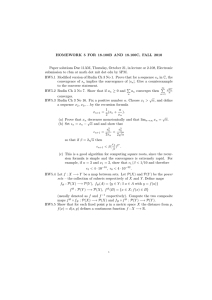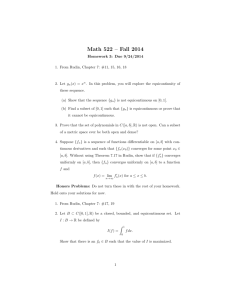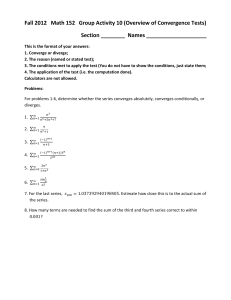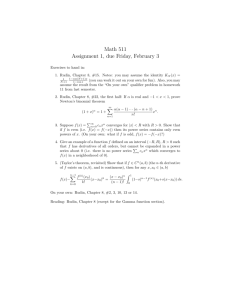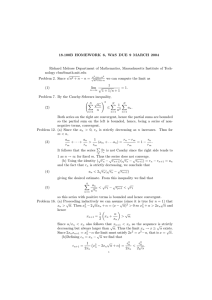HOMEWORK 5 FOR 18.100B AND 18.100C, FALL 2010 SOLUTIONS
advertisement
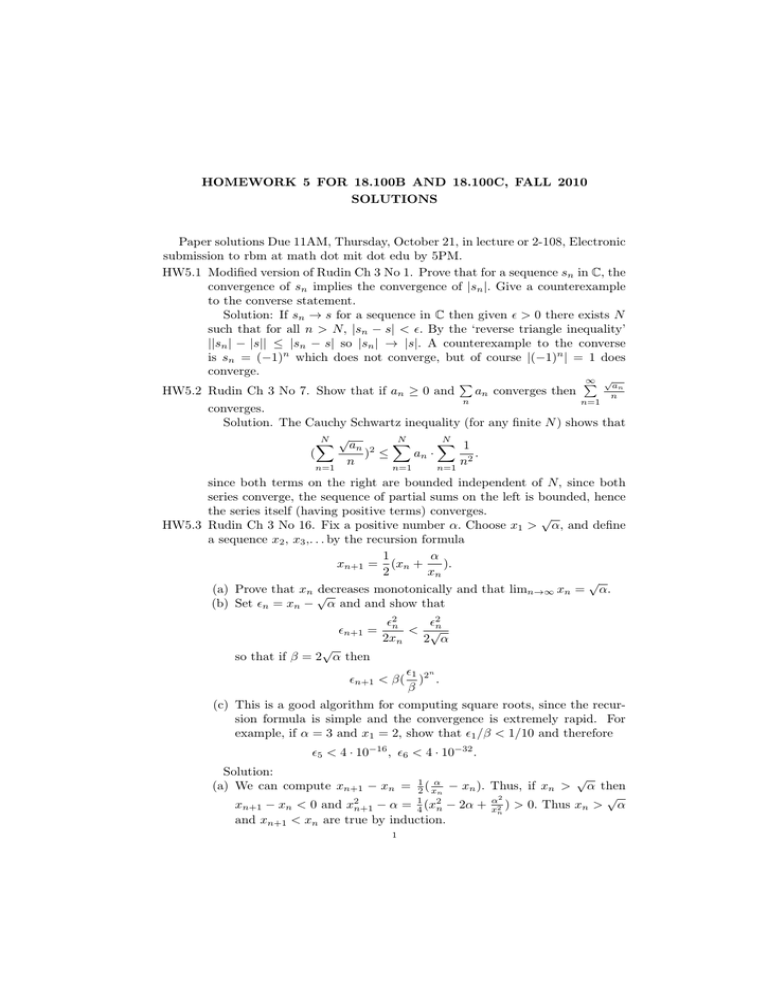
HOMEWORK 5 FOR 18.100B AND 18.100C, FALL 2010
SOLUTIONS
Paper solutions Due 11AM, Thursday, October 21, in lecture or 2-108, Electronic
submission to rbm at math dot mit dot edu by 5PM.
HW5.1 Modified version of Rudin Ch 3 No 1. Prove that for a sequence sn in C, the
convergence of sn implies the convergence of |sn |. Give a counterexample
to the converse statement.
Solution: If sn → s for a sequence in C then given > 0 there exists N
such that for all n > N, |sn − s| < . By the ‘reverse triangle inequality’
||sn | − |s|| ≤ |sn − s| so |sn | → |s|. A counterexample to the converse
is sn = (−1)n which does not converge, but of course |(−1)n | = 1 does
converge.
∞ √
P
P
an
an converges then
HW5.2 Rudin Ch 3 No 7. Show that if an ≥ 0 and
n
n
n=1
converges.
Solution. The Cauchy Schwartz inequality (for any finite N ) shows that
N
N
N √
X
X
an 2 X
1
) ≤
an ·
.
(
2
n
n
n=1
n=1
n=1
since both terms on the right are bounded independent of N, since both
series converge, the sequence of partial sums on the left is bounded, hence
the series itself (having positive terms) converges.
√
HW5.3 Rudin Ch 3 No 16. Fix a positive number α. Choose x1 > α, and define
a sequence x2 , x3 ,. . . by the recursion formula
1
α
xn+1 = (xn +
).
2
xn
√
(a) Prove that xn √
decreases monotonically and that limn→∞ xn = α.
(b) Set n = xn − α and and show that
n+1 =
√
so that if β = 2 α then
2n
2
< √n
2xn
2 α
1 2 n
) .
β
(c) This is a good algorithm for computing square roots, since the recursion formula is simple and the convergence is extremely rapid. For
example, if α = 3 and x1 = 2, show that 1 /β < 1/10 and therefore
n+1 < β(
5 < 4 · 10−16 , 6 < 4 · 10−32 .
Solution:
(a) We can compute xn+1 − xn =
x2n+1
1 α
2 ( xn
1
2
4 (xn
− xn ). Thus, if xn >
xn+1 − xn < 0 and
−α =
− 2α +
and xn+1 < xn are true by induction.
1
α2
x2n )
√
α then
√
> 0. Thus xn > α
2
HOMEWORK 5 FOR 18.100B AND 18.100C, FALL 2010 SOLUTIONS
Since
the sequence decreases monotonically
and is bounded below by
√
√
α, it converges to a limit t = α + r for some r ≥ 0. Since α/xn →
α/t and xn+1 → t the limit must satisfy t = 12 (t + αt ) and hence t2 = α
√
so t = α.
√
√
√
(b) If n = xn − α then n+1 = xn+1 − α = 12 (xn − 2 α + xαn ) =
√
√
√
(xn − α)2 /2xn = 2n /2xn < 2n /2 α since xn > α for all n. Setting
2
√
n
β = 2 α this becomes n+1
for all n > 0 and so by induction
β <
β
2n
.
n+1 < β β1
(c) You can do the computation!
HW5.4 Let f : X −→ Y be a map between sets. Let P(X) and P(Y ) be the power
sets – the collection of subsets respectively of X and Y. Define maps
f# : P(X) −→ P(Y ), f# (A) = {y ∈ Y ; ∃ a ∈ A with y = f (a)}
f # : P(Y ) −→ P(X), f # (B) = {x ∈ X; f (x) ∈ B}
(usually denoted as f and f −1 respectively). Compute the two composite
maps f # ◦ f# : P(X) −→ P(X) and f# ◦ f # : P(Y ) −→ P(Y ).
Remark. I also meant to ask you to show that f # ◦ f# (A) ⊃ A where as
f# ◦ f # (B) ⊂ B for all subsets A ⊂ X and B ⊂ Y.
Solution: This question was maybe a bit open-ended and was really
intended to get you thinking about these maps on sets, since they are used
in discussing continuity. I had in mind something like:
(1)
f # ◦ f# (A) = {x ∈ X; ∃ x0 ∈ A with f (x) = f (x0 )}
f# ◦ f # (B) = f (X) ∩ B ∀ B ⊂ Y.
Both these statements follow directly. Since x ∈ f # ◦f# (A) means precisely
that f (x) ∈ f# (A) which is exactly the condition that there exists x0 ∈ A
such that f (x) = f (x0 ). Similarly, y ∈ f# ◦ f # (B) means just that there
exists x ∈ f # (B) with f (x) = y and hence that y ∈ B∩f (X) and conversely.
The part I did not ask follows directly from (1).
HW5.5 Show that for each fixed point p in a metric space X the distance from p,
f (x) = d(x, p) defines a continuous function f : X −→ R.
Solution: By the triangle (reverse) inequality,
|f (x) − f (x0 )| = |d(x, p) − d(x0 , p)| ≤ d(x, x0 )
so given > 0 choosing δ = , d(x, x0 ) < δ implies that dR (f (x), f (x0 )) < ,
so f is continuous.
